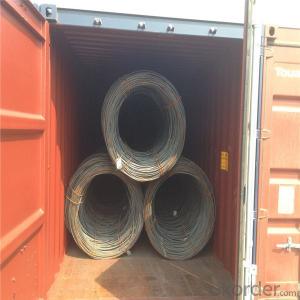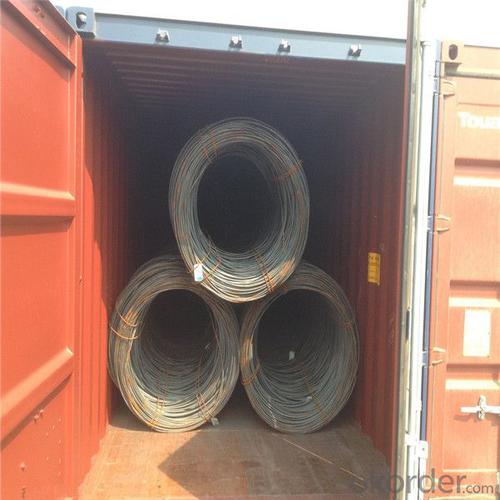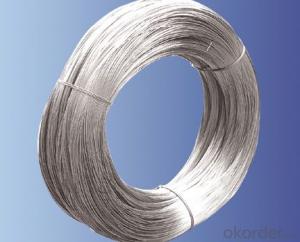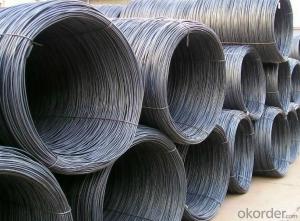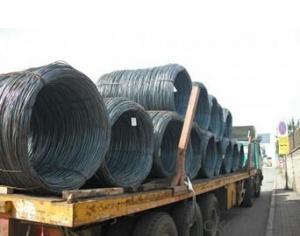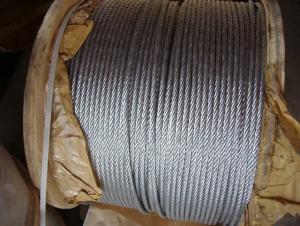Steel wire rod high quality Standard AISI, ASTM, BS, GB
- Loading Port:
- Tianjin
- Payment Terms:
- TT OR LC
- Min Order Qty:
- 50 m.t.
- Supply Capability:
- 15234 m.t./month
OKorder Service Pledge
OKorder Financial Service
You Might Also Like
Specification
Wire rod is a rolled alloy or nonalloy steel product, produced from a semi (e.g. bloom) and having a round,
rectangular or other cross-section. Particularly fine cross-sections may be achieved by subsequent cold
forming (drawing). Wire rod is wound into coils and transported in this form. .
Our Advantage: High quality steel products from 1 class mills in
Reasonable price
Professionalism of the products
On-time delivery
Complete documents and certificates
Sincere service to meet our clients' requirements
Product Description :
Standard | AISI, ASTM, BS, DIN, GB, JIS |
Material/steel grade | Q195-Q235,SAE1006B,SAE1006CR, SAE1008B, SAE1008CR, SAE1010B, SAE1018B, or according to customers requirements |
Wire Gauge | 5.5-12mm |
Coil weight | 1.8-2.1mts |
MOQ | 25MT |
Delivery Time | 15-30 days after receipt of L/C or deposit by T/T |
Packing | In coil and load in container, if large quantity, by bulk vessel; Can be packed as customers' special requirements |
Payment terms | 1).100% irrevocable L/C at sight. 2).30% T/T prepaid and the balance against the copy of B/L. 3).30% T/T prepaid and the balance against L/C |
Application | widely used in machinery parts, manufacturing industry, electronics industry, metal tools and others |
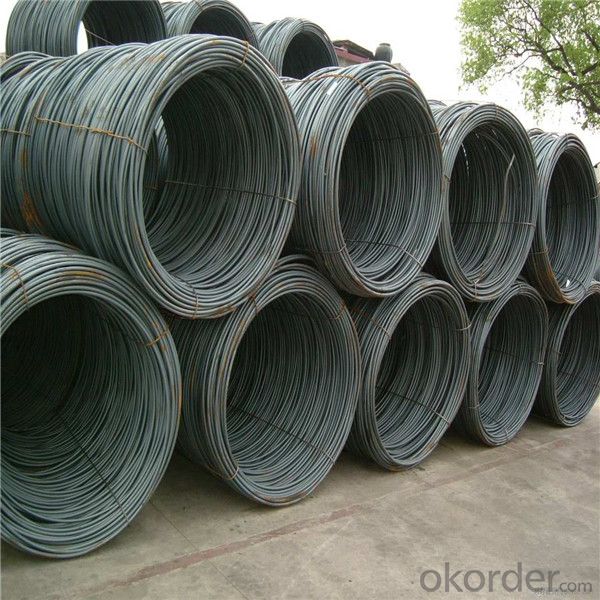

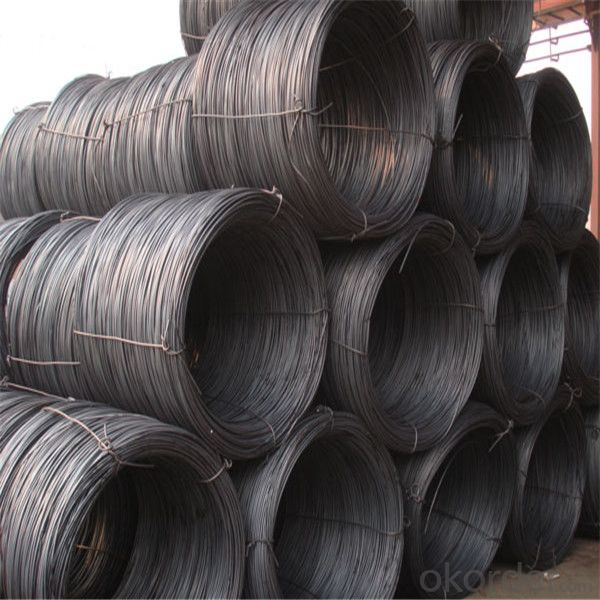
Application :
It generally used in braiding the hose for bathing product and machinery. With it
good flexibility, resistant to high temperature and resistant to corrosion, it
used widely in many industries.
Packing :
Hot-rolled wire rod is held in a unit with at least four steel straps in the
transverse direction and transported and stored without further packaging.
Before
the steel strapping is applied, the wire rod must be sufficiently compressed.
The strapping is fixed in the transverse direction with a single circumferential
strap so that the strapping does not slip and cause the coil to come apart.


Our service:
(1) We cooperate with famous factories with advanced equipment and well trained workers.
(2) We can provide factory price with trading company service.
(3) We continuously work on the improvement of our processes, guaranteeing
consistently high standards of quality to keep none compensation.
(4) We guarantee 24 hours response and 48 hours solution providing service.
(5) We accept small order quantity before formal cooperation.
(6) We deliver the agreed quality at the agreed time, reacting to changes in
customer wishes in a flexible way.
(7) Due to our volume and selling power, we have excellent freight rates with
shipping lines.
(8) We strive to always be fair and honest in our dealings with customers.
(9) We strive to work together with customers to achieve much more than we can
achieve alone.
(10) Through our passion and commitment we aim to be a market leader in all our
key markets. To maintain our position as market leader we must continue to add
value in all that we do.
FAQ:
1.Q: What's your MOQ(minimum order quantity)?
A: One full container, mixed acceptable .
2. Q: What's your packing methods?
A: Packed in bundle or bulk ..
3. Q: How can I buy CNBM products in my country?
A:Please send us an inquiry or email ,we will reply to you if there is distributor in your country
4. Q: Can we visit your factory?
A: Warmly welcome. Once we have your schedule, we will arrange the
professional sales team to follow up your case.
5. Q: How long does it take to get the product if i place an order?
A:With the process of your requirements,we will pack and deliver in 3
-7 days. If it is by sea shipment,it will take 15-45 days depending on different locations
- Q: How is steel wire rod used in the production of wire mesh for food processing?
- Steel wire rod is used in the production of wire mesh for food processing as it serves as the primary material for creating the mesh grid. The wire rod is first drawn into the desired thickness and then woven or welded together to form the mesh structure. This mesh is then used in various food processing applications such as sieving, filtering, and straining to ensure the quality and safety of food products.
- Q: What are the different types of steel wire rod coatings used for improved machinability?
- There are various types of steel wire rod coatings used for improved machinability, including zinc coatings, copper coatings, and synthetic coatings. These coatings help reduce friction and improve the cutting performance of the wire rod during machining processes, leading to better surface finish and higher productivity.
- Q: How is steel wire rod used in the manufacturing of wire rope slings for marine applications?
- Steel wire rod is a crucial component in the manufacturing of wire rope slings for marine applications. These slings are extensively used in various marine industries, including shipping, offshore oil and gas, and fishing. To begin with, steel wire rod serves as the raw material for wire rope slings. It is typically made from high-quality carbon or alloy steel, which ensures the strength and durability required for marine applications. The steel wire rod is usually produced in a continuous casting process, resulting in a long, cylindrical shape. Once the steel wire rod is obtained, it undergoes a series of manufacturing processes to transform it into wire rope slings. The first step involves drawing the steel wire rod through a die to reduce its diameter and increase its length. This process is repeated multiple times to achieve the desired wire diameter. The drawn wire is then cleaned to remove any impurities or surface contaminants. Next, the cleaned wire is twisted together to form strands. The number of strands can vary depending on the desired strength and load capacity of the wire rope sling. These strands are then tightly wound around a central core, which provides stability and support to the wire rope. The final step in the manufacturing process is the application of protective coatings to enhance the wire rope sling's resistance to corrosion and wear. Marine environments are highly corrosive due to the presence of saltwater, which can lead to the degradation of steel. Therefore, coatings such as galvanization or zinc plating are commonly applied to the wire rope to provide a barrier against corrosion. Once the steel wire rod has been transformed into a wire rope sling, it is ready for use in various marine applications. Wire rope slings are used for a wide range of purposes, including lifting heavy loads, securing cargo, and towing vessels. They are known for their high strength, flexibility, and resistance to abrasion, making them ideal for demanding marine environments. In conclusion, steel wire rod plays a vital role in the manufacturing of wire rope slings for marine applications. It serves as the raw material for wire rope production, undergoes various manufacturing processes, and is ultimately transformed into a strong and durable sling. Wire rope slings made from steel wire rod are essential tools in the marine industry, providing reliable and safe lifting and securing capabilities.
- Q: How is steel wire rod used in the manufacturing of shelving systems?
- Steel wire rod is commonly used in the manufacturing of shelving systems due to its strength and durability. The wire rod is typically formed into various shapes and sizes to create the framework and support structure of the shelving system. Firstly, steel wire rod is often used to create the vertical posts or columns of the shelving system. These posts provide the main structural support and help to maintain the overall stability of the shelving unit. The wire rod is usually bent or shaped into a desired form, such as a rectangular or circular shape, to create these vertical posts. Additionally, steel wire rod is used to create the horizontal shelves or platforms of the shelving system. These shelves are typically made by welding or attaching the wire rods to the vertical posts at various intervals, creating multiple levels for storing items. The wire rod's strength ensures that the shelves can support heavy loads without bending or warping over time. Moreover, steel wire rod is often used to create the mesh or grid pattern that is commonly seen on shelving systems. This mesh design allows for improved air circulation and visibility of the stored items. The wire rods are woven or welded together to create a sturdy mesh pattern, ensuring that items placed on the shelves can be easily accessed and viewed. Overall, steel wire rod plays a crucial role in the manufacturing of shelving systems by providing the necessary strength, durability, and structural support. Its versatility allows for various designs and configurations, making it an ideal choice for creating functional and reliable shelving systems in a wide range of settings, including warehouses, retail stores, and homes.
- Q: What are the different types of steel wire rod surface defect visualization techniques?
- There are several different types of steel wire rod surface defect visualization techniques, including visual inspection, magnetic particle inspection, ultrasonic inspection, and eddy current inspection.
- Q: What are the common defects in steel wire rod?
- Common defects in steel wire rod can include surface cracks, internal voids or inclusions, improper shape or diameter, lack of uniformity in chemical composition or mechanical properties, and poor surface finish.
- Q: What are the factors that affect the cost of steel wire rod?
- Some factors that affect the cost of steel wire rod include the price of raw materials such as iron ore and scrap metal, energy costs, transportation and logistics expenses, market demand and competition, production and manufacturing processes, labor costs, and global economic conditions.
- Q: What are the common applications of low carbon and oil tempered steel wire rod?
- Low carbon and oil tempered steel wire rod have a wide range of applications due to their unique properties. Some of the common applications of these types of steel wire rod are: 1. Springs: Low carbon and oil tempered steel wire rod are widely used in the manufacturing of springs, especially in automotive industries. These springs need to have high tensile strength, good flexibility, and excellent resistance to fatigue, which are qualities provided by these types of steel wire rod. 2. Wire ropes: Low carbon and oil tempered steel wire rod are also used in the production of wire ropes, which are extensively used in various industries like mining, construction, and transportation. The high tensile strength and durability of these steel wire rods make them suitable for handling heavy loads and enduring harsh conditions. 3. Fasteners: Another common application of low carbon and oil tempered steel wire rod is in the production of fasteners such as bolts, nuts, and screws. These steel wire rods provide the necessary strength and toughness required for fasteners to withstand high loads and prevent failure. 4. Wire meshes: Low carbon and oil tempered steel wire rod are also used in the manufacturing of wire meshes, which find applications in various industries such as agriculture, construction, and filtration. These steel wire rods offer excellent corrosion resistance and structural stability, making them ideal for applications where strength and durability are essential. 5. Automotive components: Many automotive components like seat frames, suspension systems, and brake springs are made using low carbon and oil tempered steel wire rod. These steel wire rods provide the required strength, flexibility, and resistance to wear, ensuring the safety and performance of these automotive parts. Overall, the common applications of low carbon and oil tempered steel wire rod span across various industries including automotive, construction, mining, and manufacturing, where strength, durability, and flexibility are necessary.
- Q: What are the standard straightness requirements for steel wire rod?
- The standard straightness requirements for steel wire rod typically specify that the wire rod should be straight within a certain tolerance limit, which is usually expressed as a maximum deviation from a straight line over a specified length. These requirements ensure that the wire rod is suitable for further processing and for its intended applications.
- Q: How is steel wire rod used in the manufacturing of wire for safety barriers on highways?
- Steel wire rod is a crucial component in the manufacturing process of wire for safety barriers on highways. These safety barriers, also known as guardrails, are designed to protect vehicles and their occupants by preventing them from veering off the road or colliding with hazardous obstacles. The first step in the manufacturing process involves the production of steel wire rods. These rods are created by drawing steel through a series of dies to achieve the desired diameter and strength. Steel wire rods are typically made from low-carbon or high-carbon steel, depending on the specific requirements of the safety barrier. Once the steel wire rods are produced, they are then further processed to transform them into wire for safety barriers. This process involves several steps, including cleaning, coating, and forming. The rods are thoroughly cleaned to remove any impurities and contaminants that may affect the final product's quality. Next, a protective coating is applied to the steel wire rods to enhance their durability and resistance to corrosion. This coating is usually a layer of zinc, which helps prevent rust and extends the lifespan of the wire. The rods are then fed through a series of machines that shape them into the desired wire profile for safety barriers. The final wire product is then used to manufacture the safety barriers that line highways and other roadways. These barriers are typically made by weaving or interlocking the wire together to form a strong and flexible structure. The wire is carefully designed and engineered to withstand high impact forces and effectively redirect or absorb the energy of a collision. Steel wire rod plays a critical role in the manufacturing of wire for safety barriers on highways due to its high tensile strength and durability. It provides the necessary structural integrity to ensure that the safety barriers can effectively protect motorists and pedestrians in the event of an accident. Moreover, the corrosion-resistant properties of steel wire rods ensure that the safety barriers have a longer lifespan, reducing the need for frequent maintenance and replacement.
Send your message to us
Steel wire rod high quality Standard AISI, ASTM, BS, GB
- Loading Port:
- Tianjin
- Payment Terms:
- TT OR LC
- Min Order Qty:
- 50 m.t.
- Supply Capability:
- 15234 m.t./month
OKorder Service Pledge
OKorder Financial Service
Similar products
Hot products
Hot Searches
Related keywords
